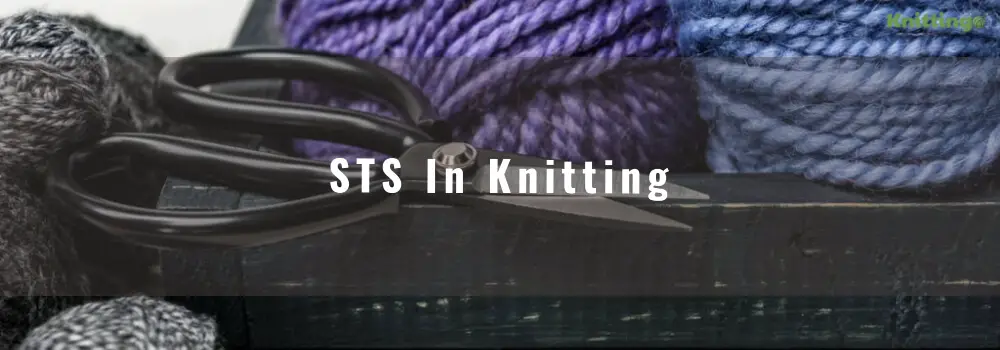In knitting, STS is the abbreviation of stitches since ST stands for a single stitch. There are several common knitting abbreviations used by knitters while knitting patterns. If you’re new to knitting, you may not understand them until you learn their meaning. It is good to learn so that you can understand other knitters perfectly and move forward in knitting crafts.
However, as time goes by, you’ll eventually get used to some common abbreviations and unusual ones that differ from one knitting pattern to another. But don’t worry too much since knitting language is easier to understand through practice and experience over time. Familiarizing with knitting abbreviations helps you when doing simple, new, and current knitting designs.
Sometimes it may be frustrating for new knitters, especially if seasoned ones assume they understand whatever is being said. Here we seek to help you by looking at the different types of stitches that are popular and easy to learn. As well, we will highlight the common abbreviations used in knitting, and why you as a knitter must use them.
What Is STS Abbreviation In Knitting?
In knitting, STS abbreviation stands for stitches with ST meaning single stitch. On the other hand, STST is used by knitters when referring to stockinette stitch. For this, you should know important abbreviations for knitters.
Basic Knitting Stitches For Beginners
Generally, knitting is based on two simple stitches, i.e., the knit stitch and the purl stitch. After that, everything else is just a variation or combination of the two stitches. The knit stitch is usually created by making a loop on the back of your work. In contrast, a purl stitch is created by making a loop in the front of your work.
The two simple stitches seem not to provide much variety, but they do much more than you can imagine. Stitch patterns are the variations of the two, although knitters refer to them as stitches. Yes, it’s a little bit confusing, but once you’ve knitted for a while, eventually, you’ll understand when knitter refers to stitch (pattern) plus others and what they meant. For example, a knitter may say, “I have knitted a sweater in stockinette stitch, though the hems and cuffs are ribbed.” Now let’s discuss some of the common and easiest stitches for a beginner;
Garter Stitch
It’s one of the easiest and very popular stitch patterns used in various knitted fabrics. Knitters make garter stitch using either knitting or purling each row. In comparison, featuring horizontal ridges created by the top of the knitted loops on each other row. Because the stitch lies flat and is reversible, this kind of stitch is suitable for blankets, washcloths, bags, scarves, and many more. Ensure you count the number of stitches after every row because new stitches might be created accidentally, especially when you’re new.
Stockinette Stitch
It’s yet another wonderful and easiest basic knitting stitch you need to know. To knit it, a knitter alternates a knit row with a purl row. Sometimes its referred to as stocking stitch, and it’s very common in a knitted garment such as hats, socks, blankets, sweaters, scarves, etc. however, you should be aware that stocking stitch has right and wrong sides (even though both sides can be right side based on the individual pattern). , the correct side is smooth and features tiny stitches and known as reverse stockinette or purl. Fabric made of stockinette stitch normally curls at the edges. The horizontal edges curls to the smooth or front side.
Seed Stitch
This kind of stitch got its name from the texture of the knitted fabric due to the small purls bumps similar to scattered seeds. Seed stitch contains single knits and purls, which alternate both vertically and horizontally. When you compare with garter and stockinette stitch, seed stitch is more complicated than the two. But the interesting texture is present in many new knitter knitting patterns. Like the garter stitch, this kind of stitch lies flat, and the knitted fabric is similar on both sides. The stitch is perfect for scarves, sweater borders, cuffs, plus other garments that both sides are usually visible.
Rib Stitch
Rib stitch is created when you alternate stitches along the row, i.e., knit one stitch, purl one stitch to create columns of knits and purls. This kind of stitch creates a stretchable fabric that is ideal for collars, sweater bands, cuffs, etc. Ribbing can be done using more combinations to create unique designs, for example, k2*p2, k3*p3, k4*p4, etc.
Reverse Stockinette Stitch
It’s similar to the stockinette stitch that’s alternating rows of knits and purl stitches. What only differs is that ridge rows are considered the front side of the fabric while the v’s are considered the backside of your work.
Basketweave Stitch
It’s among one of the greatest stitches for beginners since it looks complicated, although it’s very easy to create. The combination of the two stitches, i.e., knit and purl stitches, is similar to the woven exterior of a basket. Purl stitches seem to look like weaving in and out of the stockinette background. That’s how it got its name from. The stitch is very famous for afghans, heavy sweaters, potholders, and scarves.
Those are a few but important stitch for a beginner’s. But, as you progress with your knitting hobby, you’ll learn that various stitch patterns are beautiful and desirable. With a lot of practice, they will seem very easy for you.
Why Do Knitters Use Abbreviations?
Generally, abbreviations are used often to shorten patterns and make them easier to read. For example, a knitter might use abbreviation in a sentence like “cont. in St st, then Dec 2 st at the beg and end of alt RS rows,” which in full means “continue in stockinette stitch, then decreasing two stitches at the beginning and end of alternate right side row.” Since it’s just one line, it doesn’t look like much. But when you have to write a whole book or several pages of patterns, it’s understandable because it needs more space and time.
You’ll learn that few abbreviations are meant for single words or all to do with a single stitch as others describe several tasks performed in series. Even though these abbreviations are likely to confuse new knitters more, their absence will frustrate the experienced knitters used to such forms. When you eventually get used to these abbreviations, reading and understanding knitting patterns will be much easier.
A Common Abbreviation Used In Knitting
We are going to list some of the common abbreviations used in knitting patterns. Although in most cases where others are used, there are many, an explanation will be there somewhere in the pattern of what the designer wants you to do. Some of the abbreviations include;
Knitting Abbreviations
| Abbreviation | Meaning |
| Alt | alternate |
| Approx | approximately |
| Beg | Begin; begins; beginning |
| Bet | between |
| BO | Bind off |
| BOR | Beginning of round/ row |
| CA | Colour A |
| CB | Colour B |
| CC | Contrasting color |
| Cm | Centimeter |
| Cn | Cable needle |
| Co | Cast on |
| Cont | Continue(s) |
| Dec | Decrease(es) |
| Dpn | Double-pointed needle (s) |
| Fl | Front loop |
| Foll | Follow; following |
| G | grams |
| Inc | Increases |
| Incl | including |
| K | knit |
| K2tog | Knit two together |
| K3tog | Knit three together |
| Ktbl | Knit through back loop |
| Noise | knitwise |
| LH | Left hand |
| Lli | Left lifted increase |
| Lp(s) | Loops(s) |
| M | meters |
| Mm | millimeters |
| M1 | Make one stitch |
| M1p-st | Make one purl stitch |
| Mc | Main color |
| Oz | ounce |
| P | purl |
| Patt or pat(s) | Pattern(s) |
| P2tog | Purl two together |
| P3tog | Purl three together |
| Pm | Place marker |
| Pop | Popcorn bobble |
| Psso | Pass slipped stitch over |
| P2sso | Pass two slipped stitches over |
| Pwise | purlwise |
| Rem | Remain; remaining |
| Rep | Repeat; repeating |
| Rev st st | Reverse stockinette stitch |
| RH | Right hand |
| rnd(s) | Round(s) |
| Rs | Right side |
| RSSC | Place 2sts on cn and keep to the back; k slipped st;p1,k1, from cn |
| Skp | Slip, knit, pass slipped stitch over |
| Sk2p | Slip one stitch, knit two together; pass slipped stitch over |
| Sl1k | Slip one stitch knitwise |
| Sl1p | Slip one stitch purlwise |
| Sl st | Slip stitch |
| Sm | Slip marker |
| Ss | Slip stitches |
| Ssk | Slip, slip, knit the two stitches together |
| Sssk | Slip, slip, slip knit three slipped stitches jointly |
| St(s) | Stich (es) |
| Tbl | Through back loop |
| Tog | together |
| W&t | Wrap and turn |
| Wpi | Wraps per inch |
| Ws | Wrong side |
| Wyib | With yarn in the back |
| Wyif | With yarn in front |
| Yd(s) | Yards(s) |
| Yo | Yard over |
| Yfwd | Yarn forward |
| Yrn | Yarn around needle |
| Yon | Yarn over needle |
| * | Repeat the pattern following asterisk as directed |
| ** | Repeat the instructions after asterisks as directed |
| () | Work instructions in the parenthesis as directed or to indicate size changes |
| [] | Work instructions in the bracket as several times as directed |
What Is A St In Knitting?
St st is an abbreviation for stockinette stitch. It’s created when you repeat a knit row and a purl row for a few rows. You will know that there are evident right and wrong sides in the stockinette stitch. St st is a common type of stitch by beginners since it’s easy to knit.
How Do You Pick Up STS In Knitting?
Let’s show you how to pick the stitches along a cast-off or cast-on edge. Very helpful for someone making ribbed neckline etc. Follow these simple step by step;
Step 1: assuming you are working with the right side facing you, work from right to left like knitting a row. Then insert the right needle into your first stitch, under all strands at the top.
Step 2: wrap your new yarn around the needle.
Step 3: scoop the needle to your side, making sure you have a stitch on the needle.
Step 4: Repeat this across the edge.
Step 5: pick up the stitches across the edge, working now on the right side facing you. Insert the correct needle into your stitch under your strands
Step 6: Wrap the working yarn around the needle-like common knit stitch
Step 7: that’s all! Keep knitting until you pick up enough stitches. As per your pattern, continue picking up the stitches, rib stitch, stocking stitch, etc.
Conclusion
First, it’s important to learn the basics of knitting like cast on and bind off, working the knit stitch, and the purl stitch. Then start familiarizing yourself with abbreviations used in knitting. At first, it might not be very clear, but you will be using them like a pro as time goes by since you’ll be able to save time and make it easier to read many patterns.

